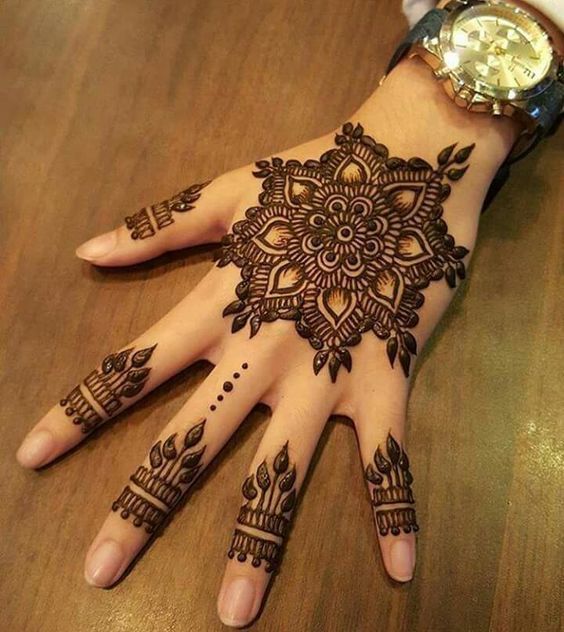Mehendi is an ancient form of body art that has been practiced in cultures around the world for centuries. Although intricate mehndi designs are beautiful and vibrant, if you’re just beginning to explore this art form, simple mehndi design provide a great starting point! In this article we will discuss some ideas for how to get started with basic mehndi design and look at some inspiring examples. So grab your mehndi cone and let’s get ready to shine!
Introduction to Mehndi Designs
Mehndi is a form of body art from India in which decorative designs are created on the skin using a paste made from the powdered dry leaves of the henna plant. Mehndi is typically applied to the hands and feet, where the color will stain the skin for several weeks.
There are many different types of mehndi designs, from simple and elegant to complex and ornate. If you’re new to mehndi, or just looking for some simple designs to try out, we’ve got you covered. Check out these easy mehndi designs for beginners!
Tips for Applying Simple Mehndi Design
There are a few things to keep in mind when choosing simple mehndi designs. The first is to pick a design that is appropriate for the occasion. If you’re attending a formal event, it’s best to choose a more subdued design. If you’re going to a party or festive gathering, you can be more adventurous with your choice. Another thing to consider is the size of the design. If you want something that will stand out, go for a larger design. But if you’re looking for something more delicate, smaller designs are better.
When it comes to applying the mehndi, there are a few things to keep in mind as well. Firstly, make sure your hands are clean and free of any oils or lotions. This will help the mehndi adhere better and last longer. Secondly, use a fine tipped applicator for precise application. And finally, take your time! Applying mehndi can be relaxing, so enjoy the process and don’t worry about being perfect.
How to Select the Right Simple Design for You
When it comes to simple mehndi design, there are a few things you should keep in mind to ensure you choose the right one for you. First and foremost, consider the occasion. If you’re looking for something to wear to a more formal event, you’ll want to steer clear of designs that are too small or delicate. Conversely, if you’re just looking for a casual design to show off on your hands or feet, you can be a little more adventurous in your choice.
Next, think about your own personal style. Do you prefer bolder, more eye-catching designs, or do you prefer something a little more understated? There’s no right or wrong answer here – it’s all about what YOU like.
Finally, don’t forget about placement. Simple designs can be placed anywhere on the body, so consider where you want your mehndi to go before making your final decision.
With all of these factors in mind, take some time to browse through different simple mehndi designs until you find one that’s perfect for you!
Popular Simple Mehndi Design Options
There are a few basic designs that are popular among those who are just starting to get into mehndi. Some of these simple designs can be done by beginners, while others may require a bit more skill. Regardless, these designs are sure to make you stand out at your next event!
1. The first design is the paisley. This design is created by making small, teardrop-shaped strokes that come to a point. They can be made as big or small as you like, and they look great when they’re filled in with color.
2. Another popular design is the spiral. This one is also fairly simple to do, and it looks beautiful when it’s done right. To create a spiral, start in the center and then make your way outwards in a circular motion.
3. The last design we’ll mention is the floral pattern. This one can be a bit more tricky, but it’s definitely worth it in the end. To create a flower, start by making a small circle and then fill it in with petals. Once you have the basic shape down, you can add as many details as you like!
Ideas and Inspiration
Are you thinking of getting a Mehndi design, but don’t know where to start? Check out these simple Mehndi design for beginners!
There are limitless possibilities when it comes to Mehndi designs. You can go for something as simple as a dotted line or a flower, or get more intricate with patterns and shapes. If you’re new to Mehndi, it’s best to start with something simple and then build up from there.
Here are some ideas and inspiration for simple Mehndi designs for beginners:
-Start with a basic outline of the design. Once you have the basic shape down, you can start to fill it in with details.
-Keep the design small and focused on one area of the hand. Too much detail can be overwhelming, especially if you’re just starting out.
-Try using a different color henna for each element of the design. This will help you create depth and dimension in your overall look.
Also Read Arabic mehndi design
Recommended Supplies and Tools
Assuming you would like tips for a beginner mehndi artist, here are some recommended supplies and tools:
-A small cone or bottle of henna paste. You can find this at a local Indian or Middle Eastern market, or online. Henna is a natural dye made from the Lawsonia inermis plant and is safe for use on the skin.
-A small paintbrush or cotton swab for applying the henna paste to the skin.
-Paper towel or napkins to catch any drips.
-Lemon juice or essential oils mixed with water in a small bowl, for setting the henna paste.
-A plastic bag or wrap to keep your hand still while the paste dries and sets.
Also Read Mehndi Designs for Girls
Conclusion
Get ready to shine with these simple Mehndi design for beginners. With a little creativity and practice, you can master the art and design perfect patterns of your own. Even if you’re not an artist, there are endless possibilities when it comes to creating unique mehndi designs that will look stunning on any occasion! So grab some supplies today and get started in making gorgeous mehndi art. Plus, it’s super fun too so don’t forget to have fun while doing this!


































Leave a Reply